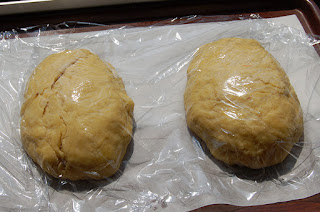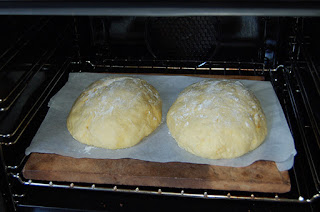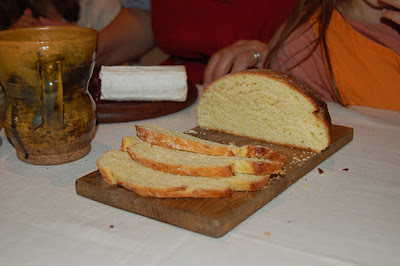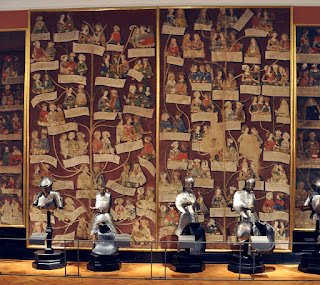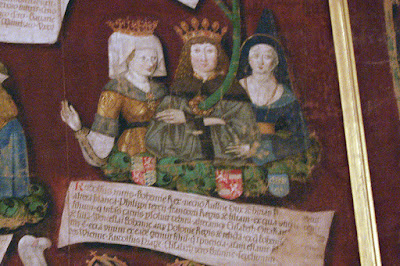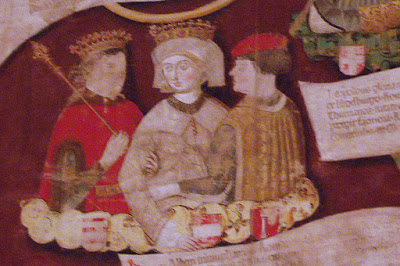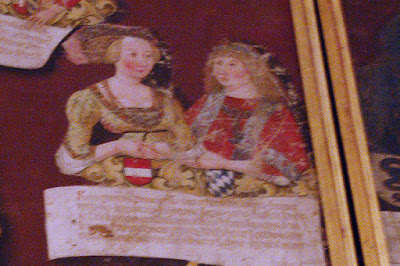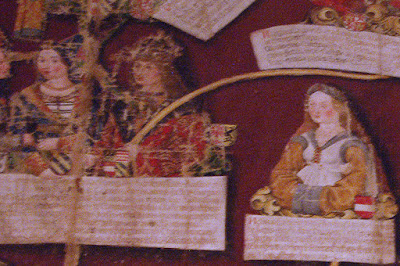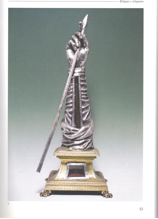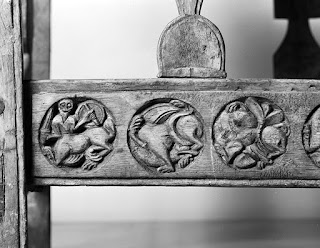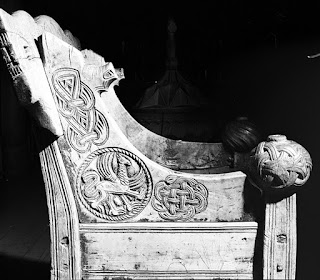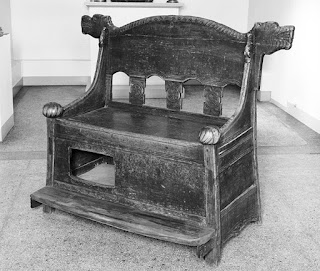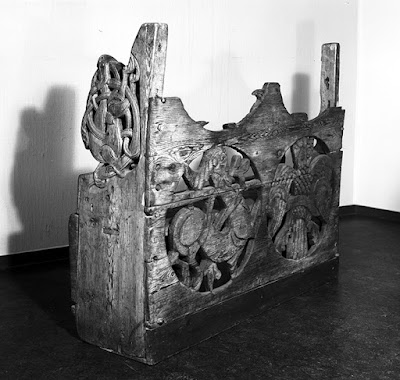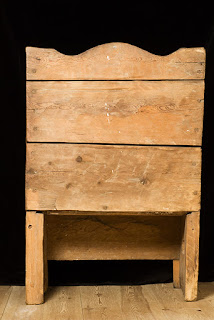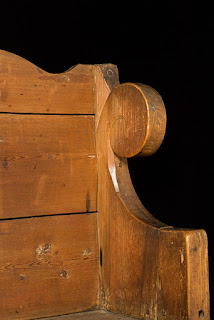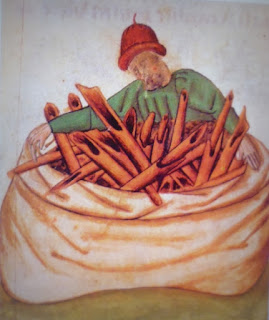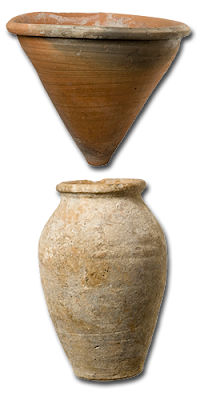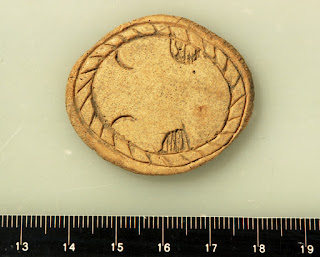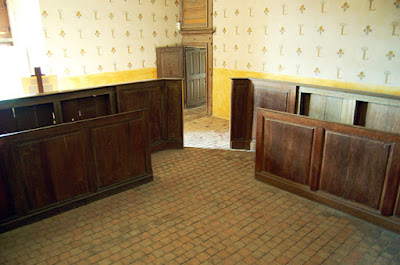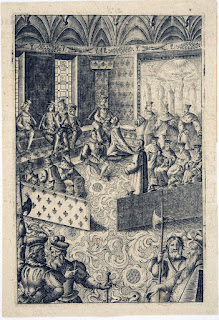This post will show the other Norwegian medieval furniture found on the
UNIMUS photoportal of the Norwegian University Museums (It seems that there are now 33 more 'Middelalder' photos since the last blogpost). It concerns mainly kinds of storage furniture like armoires, boxes and chests, but also some beds. My
previous post on Norwegian medieval furniture concerned chairs and benches. Not all medieval furniture showed up with the search term 'middelalder'; other search terms used were skap (cupboard), seng (bed), kiste (chest) and skrin (casket, box or shrine) in combination with tre (wood). Information on the furniture pieces itself was sometimes found on the other university databases.
Armoires
Armoire with iron hasps and hinges from Ukjent Fylkedating from the late Middle Ages.
The front posts are attached to the sides with eight iron fittings, of wich four extend to the two doors (39 by 30 cm). The doors are opened by spade shaped iron rings. Height 96 cm, width 53 cm, depth 35 cm. On the outside are traces of white and blue paint.
An German type 'Giebelschrank' armoire from Ardal stave church and exhibited in Bergen museum. Dated from the beginning of 13th century. The colour photo is found on Flickr and made by Arild Finne Nybø.
A wall aumbry from Borgund Stavkirke.
The linenfold panels indicate that this is a 15th-16th century piece of furniture
Chests
An ark made of pine from the farm Sauar in Heddal, Telemark.The legs of the chest stand approximately 35 cm high. The lid is roof-shaped has sloping sides and is flat in the middle. The various parts are fastened together with wooden nails, iron is only used for the hinges and hasps. The front and both end sides are decorated with rank and geometric patterns. Length 135 cm, width 83 cm, height, including the legs, 124 cm.
Another, undecorated ark from Oppland. One of the planks of the lid is missing.
![]()
![]()
![]()
![]()
![]()
![]()
![]()
A decorated chest from Oppland. Hutch type chest, where the original - roof type - lid is missing and newer, flat lid put on. At the same time the old slots for the lid were substantially sawn away. The four square corner posts were originally about 7 cm from the floor. The planks of the chest are held in place by a groove end dowel pins in the corner posts. The chest is decorated on the three leading faces. On the front, five warriors with a long, pointed chin beard are wandering in a same rhythmic motion. Over his right shoulder a spear is held. The decoration is a Viking-medieval transition. The right post frontside is decorated with a coiled snake pattern in style and iconography from late Urnes. Left post frontside has a wood-like plant with roots and side shoots that ending in leaves. The two short sides of the chest are similarly decorated with pillars and vines and foliage. Likely first half of the 1100s. Height 69.5 cm, length 139 cm, depth 71.5 cm.
![]()
![]()
![]()
A chest from from Ullensaker church, Akerhus. The chest rests on four flat corner posts in which the front and side boards are rebated and fastened with wooden dowels. The chests interior has changed in recent times and has trace of two old internal boxes. On the lid near the lock is a trace of one runic inscription. The construction was originally without any iron nails or hasps; the reinforcements on the edges were made around 15 to 1600. The coffin length is 195 cm, width 69 and 69.5 cm, heights 91.5 cm. The front is richly decorated in the fields. In the middle it is divided by a branched tree with foliage, and each half of the front is cut into 12 small squares, and these fields have carved symbolic animal figures.
A iron reinforced 6-boarded chest with three locks (of which two padlocks) from Torpo Stavkirke, Al, Buskerud.
A 6-boarded chest from Gran kirke, Hadeland
A long chest from the Lågdalsmuseet, Kongsberg , Buskerud.
A similar long chest, but without the lock from Lesja church, Lesja, Oppland.
Lectern
A lectern from Hopperstad Stavkirke.
Caskets and small boxes
A box from oak and iron from Vinje church, Rauland.
Note that the two planks from the lid are nailed together.
A similar casket made from oak and iron from Ukjent. The iron straps are of late medieval style.
Two small wooden boxes turning on a pin. Top three photos: medieval document boxes made of birch. The pivotable lid runs into a human face; the eyes are formed by iron nails. Both the lid and the long sides are decorated with carved coiled loops. the box is 39.8 cm long, 8.7 to 9 cm wide at the top and about 8 cm at the bottom, height 10.3 cm. Bottom two photos: similar document box. Apart from the lid is the box made of one piece of wood. Both long sides are carved with coiled loops. A raised edge continues horizontally along the center of the lid. Length 39 cm, width at the top approximately 9 cm, height 9 cm.
A casket from Gudbrandsdalen, Ukjent.
A wooden box with rounded lid from Ukjent. Looking at the four-pass, and architectural style of the carvings it can probably be dated to the late 14th century.
An iron and leather reinforced box from Ukjent.
A carved box from Gransherad, Ukjent.
A carved box from Teljord.The inside is divided in two compartments.
Shrine
A shrine from buskerud. Buskerud, Sigdal, Vatnås Kirke, now in the National Historic museum in Copenhagen, Denmark. Nice to see is the underside of the shrine with a small wooden door.
A wooden shrine carrier from Hedal Stavkirke.
A shrine box from the farm Jukam in Southern Aurdals, Oppland. The wooden box measures 17 inch long, 2.31 inch wide, almost 6 inch tall at the middle and 3 inch at the ends. The two long sides and the bottom are made of a piece of wood, hollowed out; the two smaller end pieces fitted with iron nails. The lid is fastened with iron hinges, and has an iron ring fitted an the top. The box could be chained to a place (according to the legend in a mountain chasm). The box could be closed with a padlock, but the bottom staple is gone. Both long sides and lid have a heavily carved exterior, with coiled lines and dragon figurines on the lid, all of a very antique stamp. Contrary, the end plates are smooth; on one of the inner sides 1350 is carved and on the other 1Z21, but these carvings are suspicious and likely much younger than the remainder of the box
Wool box
A box used to store wool from Telemark.
Bed
A bed from Telemark.
Oseberg grave finds: beds
The three beds from the Oseberg grave finds were completely broken in pieces. Therefore the photos show reproductions and drawings of these beds.
The slats underneath the mattress in small pieces of Oseberg bed 2 or 3.
Oseberg bed 1 reproduction and drawing.
Oseberg bed 2 reproduction and drawing.
Oseberg bed 3 reproduction and drawing.
Oseberg grave finds: chests
Oseberg chest O1904-178.
Oseberg chest O1904-132.
Oseberg chest O1904-156
![]()
![]()
Oseberg chest O1904-149. The heavily nailed chest consists of side planks, banding, long sides, cap locks and lock fittings. Its construction is similar to the other 'viking' chests, notably it rests, or rather stands on the side planks. Length in excess of 1.08 m, the floor (between the outer edge of side boards) 1.13 m. The width beneath the side boards 32, at the top 29 cm. Height 38 cm. Feet height above floor 16 cm. The width of the long board of 21 cm. Side planks are 2.3 cm thick. At a height of ca. 16 cm above the floor a square hole has been cut into the center of each side piece of ca. 13 cm. In this hole the end pin of the floor board is fitted. Each board is nailed to the corner plank and floor board. The lid is one piece oak, curved at the upper sideand 4 cm thick in the middle. The chest is adorned with broad iron fittings, all adorned with tinned rivet heads. Rivet heads are nailed in three parallel vertical rows, but do not go through the boards. However, on the edges and side planks are three horizontal iron fittings, which runs 7 cm on the corners. Locks are completely preserved, but rather missing the key. The lid is fastened with three iron hinges leaning. Every hasp has in the end the form of a simple animal head, and underneath which is an eye.
